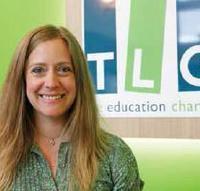Tell us a bit more about your role at TLG
RM As national intervention manager, I work with UK churches to implement our early intervention programme. The programme supports primary school children who have behavioural difficulties.
What does church involvement with this look like?
RM The churches we work with support children and families who are struggling. We train up compassionate volunteers who are free in the daytime to go and work with children in schools for an hour a week. I work closely with the people we’ve trained as coaches, supporting them as they set up their programme in schools.
What would a typical church project look like?

For some children, having an hour of adult attention is entirely unique
What happens in a coaching session?
RM The coach and child do something active together – they might make skittles or paper aeroplanes. The idea is to have fun and for the coaches to listen. The coaches ask questions about the child and their home, but all while they play, so that the spotlight isn’t directly on the child while they are talking. We have found that they begin to really open up while they’re occupied on a project together. As they build a relationship, the coach can begin to bring the encouragement that may be lacking in a busy home or classroom. The child might also raise issues that the coach can help them address. For example, they might suggest a way of responding to an anger issue – such as counting to ten in the heat of the moment – that the child could work on. The coach helps the child realise that they have choices around how they respond to their emotions.
Do you have other activities that you run with children in order to help them reflect on their feelings and behaviour?
RM The core activity that we use is called a choices flowchart. This can be created with paper bubbles, in journals, drawn or acted out using Lego. It’s about re-enacting a scenario when the child got into trouble or used behaviour in a negative way. As they re-enact what happened, they talk about the choices that they made along the way.
What does a volunteer coach look like?
RM Our eldest coaches are in their late 60s, our youngest is 18. We have a postman, retired doctors, part-time nurses, teachers, single mums, youth workers, church leaders, church workers, professionals who have been granted an hour a week by their employer. They all have compassion for children and families who are struggling.
What have you learned about the child-coach relationship?
RM A strong relationship with the child, and also with the people who are with them predominantly (their parents and teachers) is the key. If there can also be consistency in the approach taken by the coach, parents and teachers, it really helps. For some children, having an hour of adult attention is entirely unique. You could do anything in that hour – just having someone who listens and brings encouragement makes an enormous difference to their confidence and selfesteem.
1 in 6 young people who have been excluded from school will die before they reach 25
37,000 primary school children are excluded from UK schools every year.






































